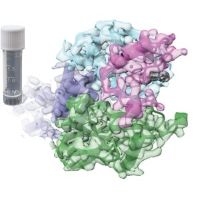Specification
| Description | Recombinant protein from the full-length sequence of homo sapiens myocilin, trabecular meshwork inducible glucocorticoid response (MYOC) (NM_000261). |
| Organism | Homo sapiens (Human) |
| Expression Host | Human Cells |
| Tag Info | His or DYKDDDDK. Please contact us if you need further information or require specific designed tag. |
| Purity | Greater than 90% by SDS-PAGE gel |
| Uniprot ID | Q99972 |
| Entry Name | MYOC_HUMAN |
| Gene Names | MYOC GLC1A TIGR |
| Alternative Gene Names | GLC1A TIGR |
| Alternative Protein Names | Myocilin (Myocilin 55 kDa subunit) (Trabecular meshwork-induced glucocorticoid response protein) [Cleaved into: Myocilin, N-terminal fragment (Myocilin 20 kDa N-terminal fragment); Myocilin, C-terminal fragment (Myocilin 35 kDa N-terminal fragment)] |
| Application | Antigens, Western, ELISA and other in vitro binding or in vivo functional assays, and protein-protein interaction studies; For research & development use only! |
| Buffer | Purified protein formulated in a sterile solution of PBS buffer, pH7.2, without any preservatives |
| Endotoxin | Endotoxin level is < 0.1 ng/µg of protein (<1EU /µg) |
| Length | 504 |
| Molecular Weight(Da) | 56972 |
| Protein Sequence | (The sequence of expressed protein may have some variation from the sequence shown below. Please contact us for the exact sequence.) MRFFCARCCSFGPEMPAVQLLLLACLVWDVGARTAQLRKANDQSGRCQYTFSVASPNESSCPEQSQAMSVIHNLQRDSSTQRLDLEATKARLSSLESLLHQLTLDQAARPQETQEGLQRELGTLRRERDQLETQTRELETAYSNLLRDKSVLEEEKKRLRQENENLARRLESSSQEVARLRRGQCPQTRDTARAVPPGSREVSTWNLDTLAFQELKSELTEVPASRILKESPSGYLRSGEGDTGCGELVWVGEPLTLRTAETITGKYGVWMRDPKPTYPYTQETTWRIDTVGTDVRQVFEYDLISQFMQGYPSKVHILPRPLESTGAVVYSGSLYFQGAESRTVIRYELNTETVKAEKEIPGAGYHGQFPYSWGGYTDIDLAVDEAGLWVIYSTDEAKGAIVLSKLNPENLELEQTWETNIRKQSVANAFIICGTLYTVSSYTSADATVNFAYDTGTGISKTLTIPFKNRYKYSSMIDYNPLEKKLFAWDNLNMVTYDIKLSKM |
Background
| Function | FUNCTION: Secreted glycoprotein regulating the activation of different signaling pathways in adjacent cells to control different processes including cell adhesion, cell-matrix adhesion, cytoskeleton organization and cell migration. Promotes substrate adhesion, spreading and formation of focal contacts. Negatively regulates cell-matrix adhesion and stress fiber assembly through Rho protein signal transduction. Modulates the organization of actin cytoskeleton by stimulating the formation of stress fibers through interactions with components of Wnt signaling pathways. Promotes cell migration through activation of PTK2 and the downstream phosphatidylinositol 3-kinase signaling. Plays a role in bone formation and promotes osteoblast differentiation in a dose-dependent manner through mitogen-activated protein kinase signaling. Mediates myelination in the peripheral nervous system through ERBB2/ERBB3 signaling. Plays a role as a regulator of muscle hypertrophy through the components of dystrophin-associated protein complex. Involved in positive regulation of mitochondrial depolarization. Plays a role in neurite outgrowth. May participate in the obstruction of fluid outflow in the trabecular meshwork. {ECO:0000250|UniProtKB:O70624, ECO:0000269|PubMed:17516541, ECO:0000269|PubMed:17984096, ECO:0000269|PubMed:18855004, ECO:0000269|PubMed:19188438, ECO:0000269|PubMed:19959812, ECO:0000269|PubMed:21656515, ECO:0000269|PubMed:23629661, ECO:0000269|PubMed:23897819}. |
| Pathway | |
| Protein Families | |
| Tissue Specificity | Detected in aqueous humor (PubMed:12697062). Detected in the eye (at protein level) (PubMed:11431441). Widely expressed. Highly expressed in various types of muscle, ciliary body, papillary sphincter, skeletal muscle, heart, and bone marrow-derived mesenchymal stem cells. Expressed predominantly in the retina. In normal eyes, found in the inner uveal meshwork region and the anterior portion of the meshwork. In contrast, in many glaucomatous eyes, it is found in more regions of the meshwork and seems to be expressed at higher levels than in normal eyes, regardless of the type or clinical severity of glaucoma. The myocilin 35 kDa fragment is detected in aqueous humor and to a lesser extent in iris and ciliary body. {ECO:0000269|PubMed:11431441, ECO:0000269|PubMed:12697062, ECO:0000269|PubMed:15795224}. |
QC Data
| Note | Please contact us for QC Data |
| Product Image (Reference Only) |  |

